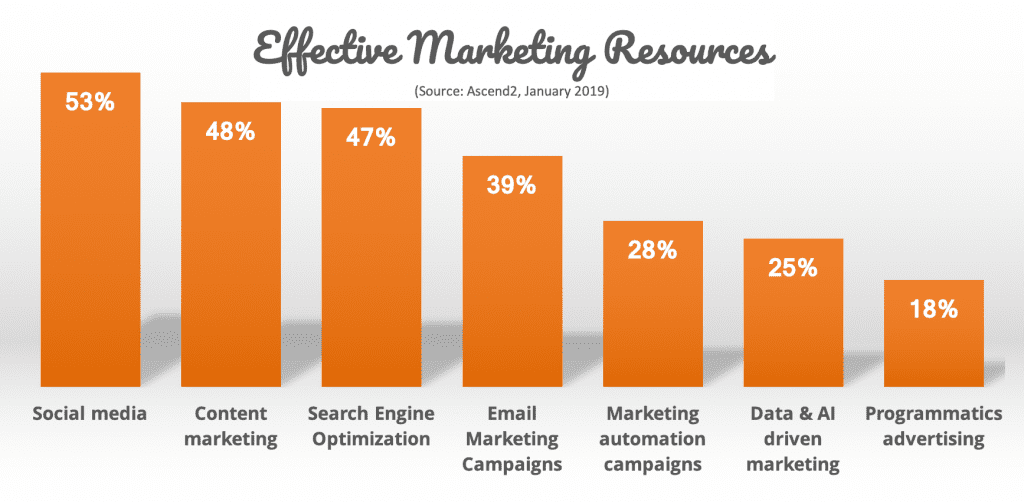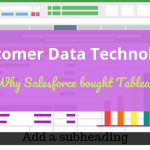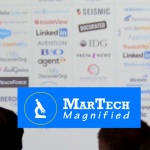
Marketing Trends for 2019 that Will Change Marketing
5 Minute Read
Getting ready for 2019, the WaveLength Analytics team took a hard look the current state of marketing. With client work and the DC Marketing Tech Talks community, we have a pretty good vantage point. One, this includes marketing functions and two, the technology that marketers use. Three, and most important, we see the results they get. We see 6 key marketing trends for 2019. Our conclusion is there’s digital saturation. In turn, it’ll drive marketers to use more levers in the marketing mix. Along with it, they’ll reallocate market budgets.
Need more proof?
According to the January 2019 Ascend2 Marketing Resource Effectiveness Study, they report that email is no longer considered the top stand-alone tactic. In fact, it’s dropped all the way down to 4th, behind social media, content marketing, and SEO.

Marketing Trends for 2019 that Will Change Marketing:
- More budget dollars will go to awareness programs
- Native advertising gets more constructive and less annoying
- Marketers will compete by respecting privacy and gaining trust
- Marketing will only send emails to people who truly want them
- Marketers realize buyers are in control
- Communities that are valuable forums continue to grow
So read on for the marketing trends in 2019 that will change marketing strategies and tactics. Oh, and it’s with a dash of what we hope to see in marketing by this time next year. It’ll be up to you to figure out the difference.
1. More Budget Dollars Will Go to Awareness Programs
Let’s lay out what we think of as awareness programs. Think thought leadership or visibility in media outlets. It could also be speaking at conferences or submitting entries for awards. Another awareness campaign could be getting active in influencer and analyst ecosystems. In recent years, they have in large part taken a back seat or been completely ignored altogether.
But the truth is, awareness and demand gen programs need to work hand in hand.
Awareness Programs Drive Organic Traffic.
What’s been overlooked is that awareness programs drive real organic traffic… and levels often impossible through demand gen efforts alone. And they provide a way for buyers to learn about a company through a third-party lens. important validation and credibility often comes along with it.
Add the fact that awareness programs are now much more measurable. In the old days, associates combed through newspapers, magazines, and trade pubs to clip articles. The old clip book was the only way to prove value. In the digital age, you can fire up Google News and get a good idea of how your awareness programs perform. In a very real sense, they are now more like demand gen. Marketers can measure results alongside or in conjunction with demand gen programs.
Demand Gen Alone is Limiting.
We already see dissatisfaction with, and limited effectiveness of, demand gen-only one-trick ponies. So in 2019, we expect that awareness programs will grow, taking a bigger part of the marketing mix. It will certainly result in more resources spent on them. Of the marketing trends for 2019 discussed here, we’re 100% confident in this one.
2. Native Advertising Gets More Constructive and Less Annoying
Let’s start with explaining native advertising. It’s actually paid ads that look, feel and function like the media format where they appear. You use them in social media feeds, or as recommended content at the bottom of the page, sadly known as click bait. But unlike banner or display ads, native ads don’t look like ads. The idea is that they’re in the editorial flow of the page to subtly advertise.
Nobody is Fooled.
That said, it needs some serious improvement to repair its click bait reputation. To that end, it will take new forms, and find new outlets. For example, more publications will take Forbes’ lead, and develop communities. The ones that will excel allow members to contribute content and to the discussion as well as get rewarded for it.
Trade Brand Visibility with Partners.
There’s another trend on the network effect. More organizations will use their digital properties to showcase partners. Let partners add content contributor opinions. Think of it like product placement in the movies. Brands and buyers will increasingly cooperate for mutual benefit.
Of all our marketing trends for 2019, this one is probably more like wishful thinking. But we’ll see.
3. Marketers Will Compete by Respecting Privacy and Gaining Trust
As all marketers know, personal data drives personalized and effective digital experiences. And of course, this is where marketers will feel the impact of GDPR impact. Simple. No data, no personalization.
Earn Customers Trust.
At the same time, getting prospects to part with their data is a bigger and bigger challenge. Nobody wants to complete forms much anymore and when they do, it’s another @#$% record. And who can blame anybody? Breaches are a daily occurrence. The phone never stops ringing and it’s sure to guarantee a lifetime of email.
Time to do something different. How about following those email preferences? If someone doesn’t want your email, don’t send it to them anyway. Don’t spend your money. Instead, let’s go back to getting individual consent. Make sure, importantly, that using personal data does not violate privacy or trust.
This way, you get data. Then you improve personal experiences and thrive even more.
Give Real Value in Exchange for Customer Data.
Think of it this way: It’s like a loyalty program at your local retailer. Make the deal sweet enough, people willingly give personal information. Organizations need to up their game. They need to provide personalized digital experiences that are so valuable that no one can refuse. And never, ever violate privacy and abuse that trust. Marketers can’t truly exploit the promise of artificial intelligence without good data, so time to start working on it.
4. Marketing Will Only Send Emails to People Who Truly Want Them
Like it or not, the days of spray and pray, of mindlessly sending marketing emails is coming to an end.
Sure, you’re about to blame GDPR, but deliverability is now the big deal. It’s getting harder to get to the inbox. Hosted email, like Microsoft Office 365 separates out “focused” from “other” email. Or in Gmail, it’s “Primary” or “Social” or “Promotions” tabs getting in your way. And then there’s the “junk” folder and email provider hosted anti-spamming.
Marketers have no control over this, so time to think differently. Create great content that is true thought leadership. Let prospects opt into your marketing emails. Anything else is a waste of everyone’s time and money.
5. Marketers Remember Buyers Are in Control
First, make sure you understand our definition of the buyer journey vs. customer journey. The buyer journey ends at the sale. Meanwhile, the customer journey continues to include customer experience with the seller.
Only Certainty in the Funnel: Prospects and Customers.
In either case, it’s important to allow the buyer to control it. Allow them to own their journey to buy because they do anyway. And touching them at every step? That’s, in the end, a myth.
Why? Because there’s no such thing as a linear buyer journey. Every buyer moves through stages at different rates. Forget it, you can’t predict it. At least not yet anyway.
So the task is for marketers to arm the customer with all the information needed to quickly self-select out or move to the next stage. In 2019, there will be a return to high quality content and campaigns. And, at last, away from effortless digital pollution.
Concentrate on Building the Relationship.
When a buyer becomes a customer, it’s critical to remember that what you’re really doing is building a relationship. Making sure a customer gets the value they expect. Solving problems they encounter, hence, are the building blocks of loyalty. And respecting their time will be table-stakes.
6. Communities that are Valuable Forums Continue to Grow
As for the last of our marketing trends for 2019, we think communities will continue to grow. As founders of a community of marketers, we’re big believers in Bricks and Clicks. So why? At the end of the day, business is all about relationships. That said, there’s a huge role for online communities that offer value. Github, recently bought by Microsoft, is probably the best example.
Roll Your Own.
Some companies are building their own. Some good examples are NetApp’s The Pub and Juniper’s recently launched NRE Labs.
Not a Strategy for Wimps.
Keep in mind that communities take commitment. For one, they’re long-term plays. Second, they need subject matters to support it, to get it off the ground. Lastly, Communities are about as opposite of the whole mindless automated marketing tactics you can get. But done well, bring like-minded people together and grow skill sets. They also foster innovation, build relationships, and everyone wins.
The Last Word on the 6 Marketing Trends for 2019
Last year’s marketing tactics probably won’t work this year. Markets and customers, after all, constantly change too much for that. Buyers, at this point in time, have a hard time seeing through the digital pollution. So it’s never been more important to build relationships based on trust.
The only thing that is certain, though, is that modern marketing doesn’t stand still.
What marketing trends for 2019 will you pioneer?
Hey! Friends help friends grow by hitting those share buttons!








